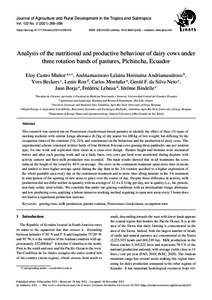| dc.date.accessioned | 2021-12-13T11:26:25Z | |
| dc.date.available | 2021-12-13T11:26:25Z | |
| dc.date.issued | 2021-12-08 | |
| dc.identifier | doi:10.17170/kobra-202112035148 | |
| dc.identifier.uri | http://hdl.handle.net/123456789/13433 | |
| dc.language.iso | eng | eng |
| dc.rights | Namensnennung 4.0 International | * |
| dc.rights.uri | http://creativecommons.org/licenses/by/4.0/ | * |
| dc.subject | grazing time | eng |
| dc.subject | milk production | eng |
| dc.subject | pasture rotation | eng |
| dc.subject | Pennisetum clandestinum | eng |
| dc.subject | occupation time | eng |
| dc.subject.ddc | 630 | |
| dc.title | Analysis of the nutritional and productive behaviour of dairy cows under three rotation bands of pastures, Pichincha, Ecuador | eng |
| dc.type | Aufsatz | |
| dcterms.abstract | This research was carried out on Pennisetum clandestinum-based pastures to identify the effect of three (3) types of stocking methods with similar forage allowance (8.2 kg of dry matter for 100 kg of live weight) but differing by the occupation times of the rotations (3 h, 24 h, and continuous) on the behaviour and the production of dairy cows. The experimental scheme consisted in three herds of four Holstein Friesian cows grazing three paddocks, one per rotation type, for one week and replicated three times in a cross-over design. Pasture height and biomass were measured before and after each grazing week and on a daily basis, two cows per herd were monitored during daytime with activity sensors and their milk production was recorded. The main results showed that in all treatments the cows reduced the height of the sward by 40% on average. The cows in the continuous treatment spent more time in meals and tended to have higher average speed during the day than in the 3-h rotation ascribed to a higher exploration of the whole gradable area every day in the continuous treatment and to more time idling animals in the 3-h treatment in anticipation of the opening of new areas to graze over the course of day. Despite those difference in activity, milk production did not differ neither in quantity with an average of 12.4 0.14 kg per day, nor in quality (i.e., fat, protein, non-fatty solids, total solids). We conclude that under our grazing conditions with an intermediate forage allowance and low producing cows, applying a labour intensive stocking method requiring to open new areas every 3 hours does not lead to a significant production increase. | eng |
| dcterms.accessRights | open access | |
| dcterms.creator | Muñoz, Eloy Castro | |
| dcterms.creator | Andriamandroso, Andriamasinoro Lalaina Herinaina | |
| dcterms.creator | Beckers, Yves | |
| dcterms.creator | Ron, Lenin | |
| dcterms.creator | Montufar, Carlos | |
| dcterms.creator | Félix da Silva Neto, Gentil | |
| dcterms.creator | Borja, Juan | |
| dcterms.creator | Lebeau, Frédéric | |
| dcterms.creator | Bindelle, Jérôme | |
| dc.subject.swd | Ecuador | ger |
| dc.subject.swd | Milchproduktion | ger |
| dc.subject.swd | Weide <Landwirtschaft> | ger |
| dc.subject.swd | Kikuyugras | ger |
| dc.subject.swd | Milchkuh | ger |
| dc.type.version | publishedVersion | |
| dcterms.source.identifier | eissn:2363-6033 | |
| dcterms.source.issue | No. 2 | |
| dcterms.source.journal | Journal of Agriculture and Rural Development in the Tropics and Subtropics (JARTS) | eng |
| dcterms.source.pageinfo | 289-298 | |
| dcterms.source.volume | Vol. 122 | |
| kup.iskup | false | |


